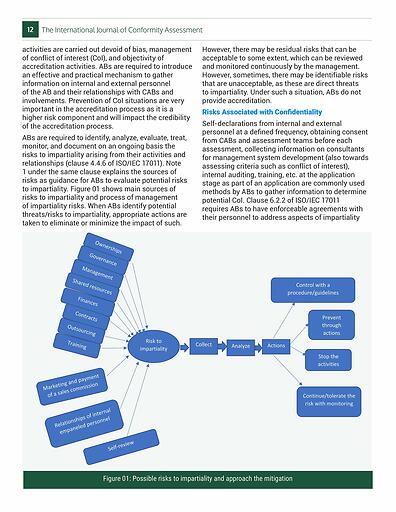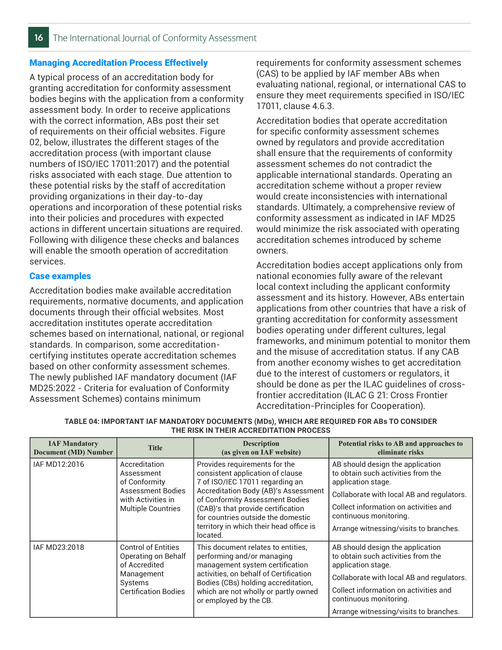IJCA - Volume 2 - Flipbook - Page 14

14
The International Journal of Conformity Assessment
skills relevant to the accreditation schemes and the
geographic areas in which they operate.
The existence of any significant gaps between
requirements and the AB’s process will create
a risk associated with competency. Lack of
required competency will impact significantly on
the credibility of accreditation services offered
by the AB. Therefore, defining competencerelated requirements for each personnel category
(clause 6.1.2 of ISO/IEC 17011) includes selection,
training, supervision, monitoring, and evaluation of
competencies prior to authorization. These are to
be included in the AB’s competence management
process (6.1.3 of ISO/IEC 17011). The application of
different monitoring techniques in a planned manner
would assist ABs to identify the competency gaps
of individuals and minimize the risk associated with
activities performed by such personnel (Ex. 6.1.5/6 of
ISO/IEC 17011).
When there is higher turnover in a particular
category or at the initial stage of launching a new
scheme, ABs have higher competency-related risk
than the management of well-established schemes
with well-experienced personnel. In particular,
global ABs are required to consider the risks
associated with personnel operating from different
countries, cultures, and the management of their
competencies. To minimize risks associated with
competency, ABs should consider increasing the
frequencies of onsite monitoring and apply whatever
different techniques (onsite observation/witnessing)
are possible. These involve techniques associated
with reporting, reviewing, and obtaining feedback
and complaints, etc. to monitor the competency of
personnel.
When an AB outsources its accreditation activities to
other ABs or individuals associated with other ABs,
the application of similar processes for competency
management will prevent any potential risk. For all
categories, the availability of written procedures,
policies, guidelines, and instructions will contribute
to preventing or minimizing risks associated with
the performance of personnel (6.2.3, 6.4.5 of ISO/IEC
17011).
Due attention of ABs is required to ensure the
availability of relevant and competent personnel for
decision-making as well as handling of appeals.
The absence of competent personnel in one or both
activities is also a higher risk for the credibility of
accreditation services. Therefore, the availability
of competent personnel for decision-making and
handling appeals will be helpful for ABs to manage
their accreditation activities to achieve a minimum
risk or no risk situation.
Failure to acquire the knowledge and skills required
for personnel involved in specific accreditation
schemes as defined by the scheme owner or relevant
IAF documents (e.g., IAF MD14, Annex B for GHG as
per ISO 14065, IAF MD13 for ISMS, clause MD 6.2.1
of IAF MD 16 for FSMS, and IAF MD 20) is considered
a critical risk for the outcome of accreditation
activities. Therefore, ABs are required to review
relevant scheme criteria or IAF documents to identify
specific requirements for knowledge and skills and
comply with them. An example to show variation in
complying with requirements is given in Table 03.
TABLE 03: VARIATIONS IN COMPLYING WITH THE
REQUIREMENTS BY TWO ABs
Accreditation Body – A
Accreditation Body – B
Competency
requirements are defined
in general.
Competency requirements are
defined to meet the required
knowledge and skills to manage
the scope of accreditation activities
and each technical area.
Therefore, it is very
difficult to match the
scope of CABs and
assessors.
Required competencies can be
sourced correctly and easily.
The personnel who select the
assessment team can easily judge
the team competency.
Lack of effective
process for competence
evaluation to ensure that
personnel are competent.
Use of different techniques, such as
interviews, document review, onsite
evaluations, shadow assessments,
onsite mentoring, use of feedback
and complaints, and review of
reports are implemented, and
records are also maintained.
Training needs are not
identified considering the
outcome of monitoring
activities.
Use of outcome of monitoring
activities and other sources for
identification of training needs
are available, and records are also
maintained.
Feedback from peers is
not obtained.
Feedback from peers is
obtained and regular technical
harmonization meetings are
conducted to share important
technical points.
The collection of up-todate qualifications and
affiliations is not evident.
Personnel files are maintained for
each staff and up-to-date records
are available.
Assessors are not trained Assessors are trained to apply riskto apply risk-based
based assessment techniques and
assessment techniques. develop personnel attributes.













